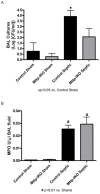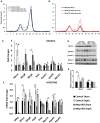Intestine-specific Mttp deletion decreases mortality and prevents sepsis-induced intestinal injury in a murine model of Pseudomonas aeruginosa pneumonia
- PMID: 23145105
- PMCID: PMC3493497
- DOI: 10.1371/journal.pone.0049159
Intestine-specific Mttp deletion decreases mortality and prevents sepsis-induced intestinal injury in a murine model of Pseudomonas aeruginosa pneumonia
Abstract
Background: The small intestine plays a crucial role in the pathophysiology of sepsis and has been referred to as the "motor" of the systemic inflammatory response. One proposed mechanism is that toxic gut-derived lipid factors, transported in mesenteric lymph, induce systemic injury and distant organ failure. However, the pathways involved are yet to be defined and the role of intestinal chylomicron assembly and secretion in transporting these lipid factors is unknown. Here we studied the outcome of sepsis in mice with conditional, intestine-specific deletion of microsomal triglyceride transfer protein (Mttp-IKO), which exhibit a block in chylomicron assembly together with lipid malabsorption.
Methodology/principal findings: Mttp-IKO mice and controls underwent intratracheal injection with either Pseudomonas aeruginosa or sterile saline. Mttp-IKO mice exhibited decreased seven-day mortality, with 0/20 (0%) dying compared to 5/17 (29%) control mice (p<0.05). This survival advantage in Mttp-IKO mice, however, was not associated with improvements in pulmonary bacterial clearance or neutrophil infiltration. Rather, Mttp-IKO mice exhibited protection against sepsis-associated decreases in villus length and intestinal proliferation and were also protected against increased intestinal apoptosis, both central features in control septic mice. Serum IL-6 levels, a major predictor of mortality in human and mouse models of sepsis, were elevated 8-fold in septic control mice but remained unaltered in septic Mttp-IKO mice. Serum high density lipoprotein (HDL) levels were reduced in septic control mice but were increased in septic Mttp-IKO mice. The decreased levels of HDL were associated with decreased hepatic expression of apolipoprotein A1 in septic control mice.
Conclusions/significance: These studies suggest that strategies directed at blocking intestinal chylomicron secretion may attenuate the progression and improve the outcome of sepsis through effects mediated by metabolic and physiological adaptations in both intestinal and hepatic lipid flux.
Conflict of interest statement
Figures








Similar articles
-
Intestine-specific deletion of microsomal triglyceride transfer protein increases mortality in aged mice.PLoS One. 2014 Jul 10;9(7):e101828. doi: 10.1371/journal.pone.0101828. eCollection 2014. PLoS One. 2014. PMID: 25010671 Free PMC article.
-
Intestine-Specific Mttp Deletion Increases the Severity of Experimental Colitis and Leads to Greater Tumor Burden in a Model of Colitis Associated Cancer.PLoS One. 2013 Jun 21;8(6):e67819. doi: 10.1371/journal.pone.0067819. Print 2013. PLoS One. 2013. PMID: 23805328 Free PMC article.
-
Liver X receptor agonist modulation of cholesterol efflux in mice with intestine-specific deletion of microsomal triglyceride transfer protein.Arterioscler Thromb Vasc Biol. 2012 Jul;32(7):1624-31. doi: 10.1161/ATVBAHA.112.246066. Epub 2012 May 10. Arterioscler Thromb Vasc Biol. 2012. PMID: 22580900 Free PMC article.
-
Role of intestinal epithelial apoptosis in survival.Curr Opin Crit Care. 2003 Apr;9(2):159-63. doi: 10.1097/00075198-200304000-00013. Curr Opin Crit Care. 2003. PMID: 12657980 Review.
-
Host stress and virulence expression in intestinal pathogens: development of therapeutic strategies using mice and C. elegans.Curr Pharm Des. 2011;17(13):1254-60. doi: 10.2174/138161211795703771. Curr Pharm Des. 2011. PMID: 21470113 Free PMC article. Review.
Cited by
-
Intestine-specific deletion of microsomal triglyceride transfer protein increases mortality in aged mice.PLoS One. 2014 Jul 10;9(7):e101828. doi: 10.1371/journal.pone.0101828. eCollection 2014. PLoS One. 2014. PMID: 25010671 Free PMC article.
-
Pathophysiology of the Gut and the Microbiome in the Host Response.Pediatr Crit Care Med. 2017 Mar;18(3_suppl Suppl 1):S46-S49. doi: 10.1097/PCC.0000000000001046. Pediatr Crit Care Med. 2017. PMID: 28248833 Free PMC article. Review.
-
Chronic alcohol ingestion increases mortality and organ injury in a murine model of septic peritonitis.PLoS One. 2013 May 22;8(5):e62792. doi: 10.1371/journal.pone.0062792. Print 2013. PLoS One. 2013. PMID: 23717394 Free PMC article.
-
Inhibition of intestinal epithelial apoptosis improves survival in a murine model of radiation combined injury.PLoS One. 2013 Oct 28;8(10):e77203. doi: 10.1371/journal.pone.0077203. eCollection 2013. PLoS One. 2013. PMID: 24204769 Free PMC article.
-
An inducible intestinal epithelial cell-specific NHE3 knockout mouse model mimicking congenital sodium diarrhea.Clin Sci (Lond). 2020 Apr 30;134(8):941-953. doi: 10.1042/CS20200065. Clin Sci (Lond). 2020. PMID: 32227118 Free PMC article.
References
-
- Heron M, Hoyert DL, Murphy SL, Xu J, Kochanek KD, et al. (2009) Deaths: final data for 2006. Natl Vital Stat Rep 57: 1–134. - PubMed
-
- American College of Chest Physicians/Society of Critical Care Medicine Consensus Conference: definitions for sepsis and organ failure and guidelines for the use of innovative therapies in sepsis. Crit Care Med 20: 864–874. - PubMed
-
- Wenzel RP, Edmond MB (2012) Septic shock–evaluating another failed treatment. N Engl J Med 366: 2122–2124. - PubMed
-
- Hassoun HT, Kone BC, Mercer DW, Moody FG, Weisbrodt NW, et al. (2001) Post-injury multiple organ failure: the role of the gut. Shock 15: 1–10. - PubMed
Publication types
MeSH terms
Substances
Grants and funding
- GM095442/GM/NIGMS NIH HHS/United States
- GM082008/GM/NIGMS NIH HHS/United States
- R01 GM072808/GM/NIGMS NIH HHS/United States
- R01 HL038180/HL/NHLBI NIH HHS/United States
- GM072808/GM/NIGMS NIH HHS/United States
- R01 GM066202/GM/NIGMS NIH HHS/United States
- DK56260/DK/NIDDK NIH HHS/United States
- GM66202/GM/NIGMS NIH HHS/United States
- T32 GM095442/GM/NIGMS NIH HHS/United States
- HL38180/HL/NHLBI NIH HHS/United States
- P30 DK52574/DK/NIDDK NIH HHS/United States
- R37 HL038180/HL/NHLBI NIH HHS/United States
- F32 GM082008/GM/NIGMS NIH HHS/United States
- R01 DK056260/DK/NIDDK NIH HHS/United States
- P30 DK052574/DK/NIDDK NIH HHS/United States
LinkOut - more resources
Full Text Sources
Medical
Molecular Biology Databases

